Ethical Clothing Report: An Analysis of Issues and Solutions
VerifiedAdded on 2020/12/30
|8
|1754
|410
Report
AI Summary
This report delves into the multifaceted issues surrounding ethical clothing, encompassing production, design, retail, and purchasing practices. It highlights the detrimental impacts on workers, communities, and the environment, particularly within the fast-fashion industry. The report examines concerns such as child labor, low wages, unsustainable production methods, environmental degradation due to chemical usage and waste, and animal cruelty. It also explores ways to address these challenges, including the role of organizations like Ethical Clothing Australia, government regulations, and citizen engagement in promoting sustainable development and ethical practices within the fashion industry. The report emphasizes the need for a shift in responsibilities among companies, consumers, and governments to ensure fair labor practices, environmental protection, and the overall sustainability of the clothing industry.
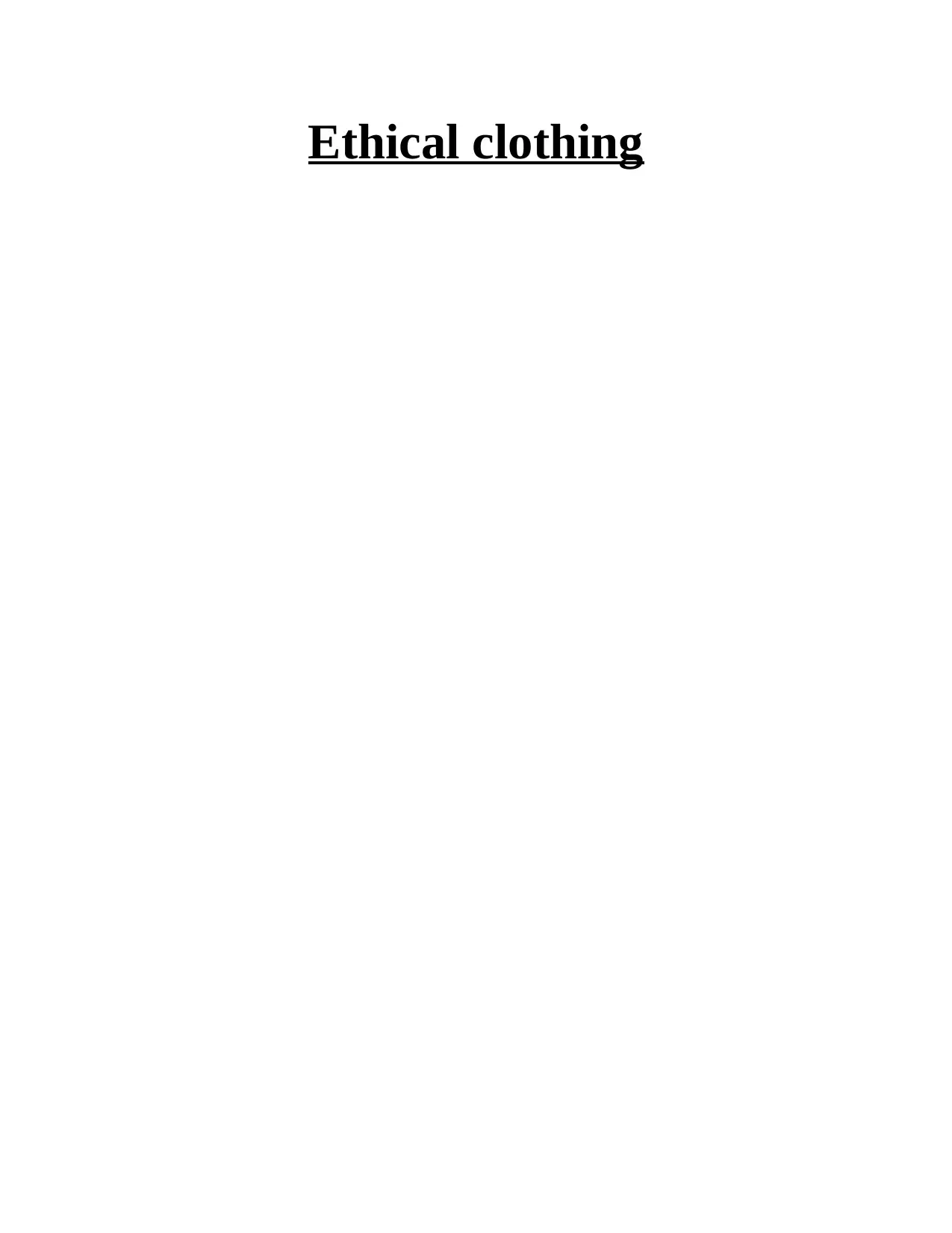
Ethical clothing
Paraphrase This Document
Need a fresh take? Get an instant paraphrase of this document with our AI Paraphraser
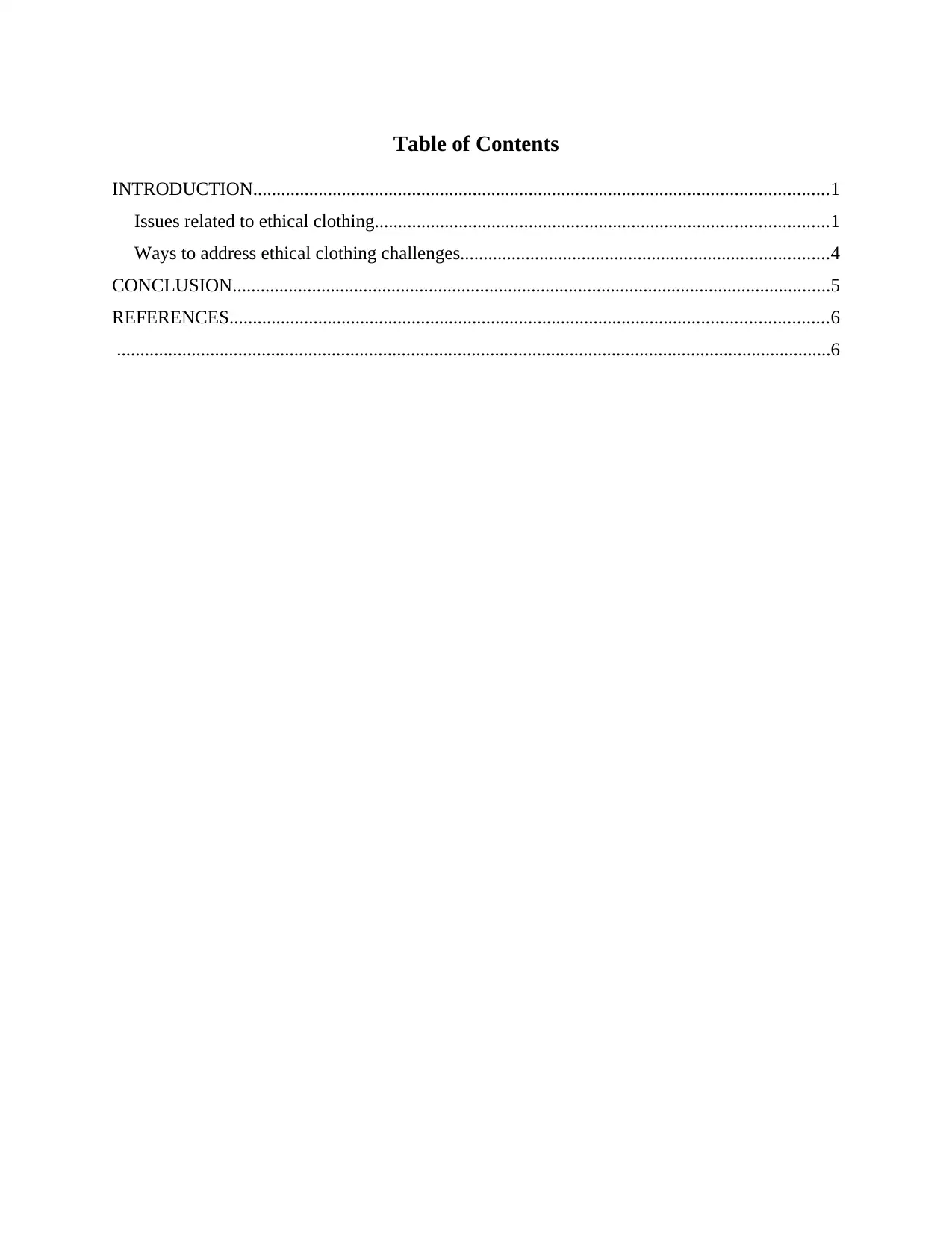
Table of Contents
INTRODUCTION...........................................................................................................................1
Issues related to ethical clothing.................................................................................................1
Ways to address ethical clothing challenges...............................................................................4
CONCLUSION................................................................................................................................5
REFERENCES................................................................................................................................6
.........................................................................................................................................................6
INTRODUCTION...........................................................................................................................1
Issues related to ethical clothing.................................................................................................1
Ways to address ethical clothing challenges...............................................................................4
CONCLUSION................................................................................................................................5
REFERENCES................................................................................................................................6
.........................................................................................................................................................6
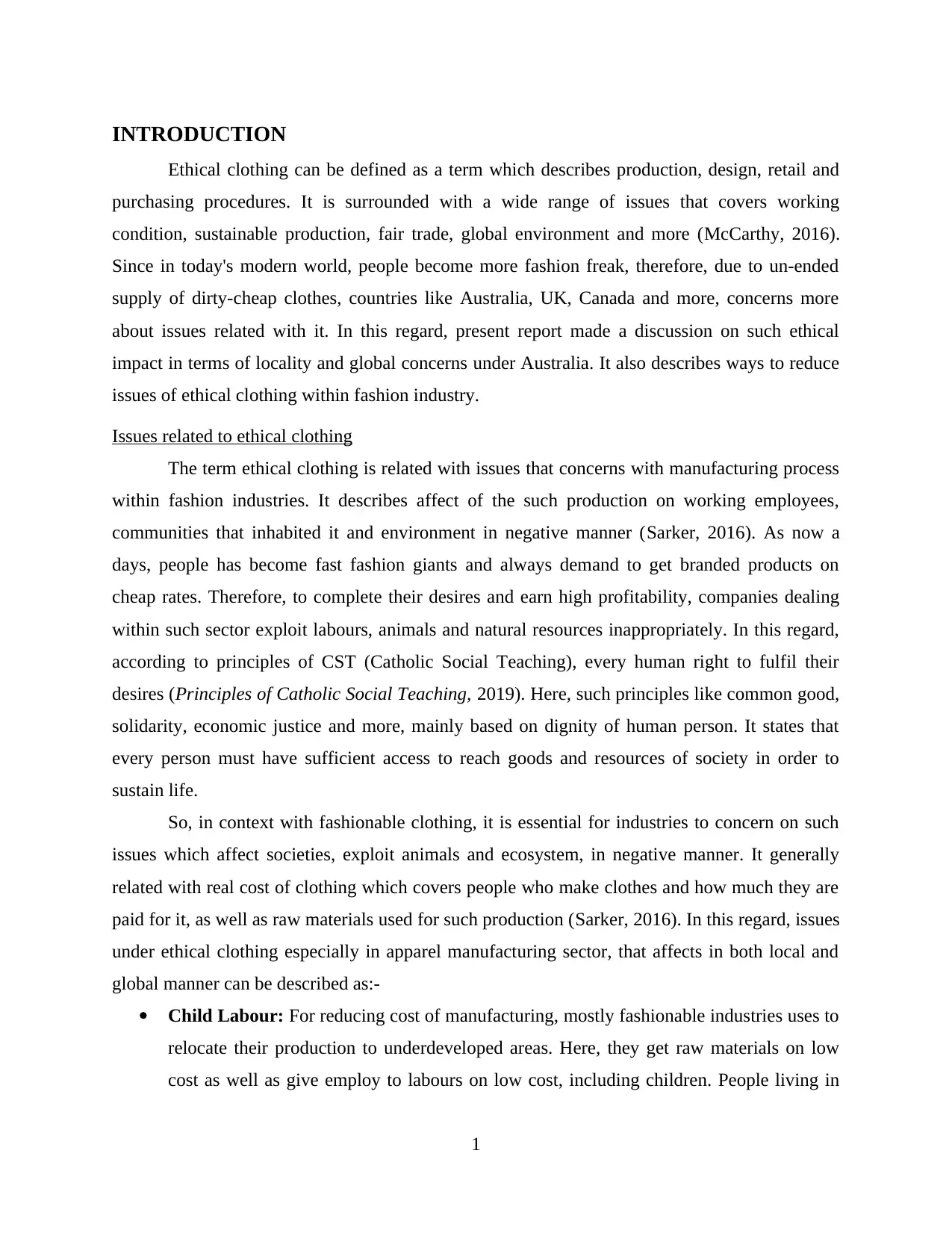
INTRODUCTION
Ethical clothing can be defined as a term which describes production, design, retail and
purchasing procedures. It is surrounded with a wide range of issues that covers working
condition, sustainable production, fair trade, global environment and more (McCarthy, 2016).
Since in today's modern world, people become more fashion freak, therefore, due to un-ended
supply of dirty-cheap clothes, countries like Australia, UK, Canada and more, concerns more
about issues related with it. In this regard, present report made a discussion on such ethical
impact in terms of locality and global concerns under Australia. It also describes ways to reduce
issues of ethical clothing within fashion industry.
Issues related to ethical clothing
The term ethical clothing is related with issues that concerns with manufacturing process
within fashion industries. It describes affect of the such production on working employees,
communities that inhabited it and environment in negative manner (Sarker, 2016). As now a
days, people has become fast fashion giants and always demand to get branded products on
cheap rates. Therefore, to complete their desires and earn high profitability, companies dealing
within such sector exploit labours, animals and natural resources inappropriately. In this regard,
according to principles of CST (Catholic Social Teaching), every human right to fulfil their
desires (Principles of Catholic Social Teaching, 2019). Here, such principles like common good,
solidarity, economic justice and more, mainly based on dignity of human person. It states that
every person must have sufficient access to reach goods and resources of society in order to
sustain life.
So, in context with fashionable clothing, it is essential for industries to concern on such
issues which affect societies, exploit animals and ecosystem, in negative manner. It generally
related with real cost of clothing which covers people who make clothes and how much they are
paid for it, as well as raw materials used for such production (Sarker, 2016). In this regard, issues
under ethical clothing especially in apparel manufacturing sector, that affects in both local and
global manner can be described as:-
Child Labour: For reducing cost of manufacturing, mostly fashionable industries uses to
relocate their production to underdeveloped areas. Here, they get raw materials on low
cost as well as give employ to labours on low cost, including children. People living in
1
Ethical clothing can be defined as a term which describes production, design, retail and
purchasing procedures. It is surrounded with a wide range of issues that covers working
condition, sustainable production, fair trade, global environment and more (McCarthy, 2016).
Since in today's modern world, people become more fashion freak, therefore, due to un-ended
supply of dirty-cheap clothes, countries like Australia, UK, Canada and more, concerns more
about issues related with it. In this regard, present report made a discussion on such ethical
impact in terms of locality and global concerns under Australia. It also describes ways to reduce
issues of ethical clothing within fashion industry.
Issues related to ethical clothing
The term ethical clothing is related with issues that concerns with manufacturing process
within fashion industries. It describes affect of the such production on working employees,
communities that inhabited it and environment in negative manner (Sarker, 2016). As now a
days, people has become fast fashion giants and always demand to get branded products on
cheap rates. Therefore, to complete their desires and earn high profitability, companies dealing
within such sector exploit labours, animals and natural resources inappropriately. In this regard,
according to principles of CST (Catholic Social Teaching), every human right to fulfil their
desires (Principles of Catholic Social Teaching, 2019). Here, such principles like common good,
solidarity, economic justice and more, mainly based on dignity of human person. It states that
every person must have sufficient access to reach goods and resources of society in order to
sustain life.
So, in context with fashionable clothing, it is essential for industries to concern on such
issues which affect societies, exploit animals and ecosystem, in negative manner. It generally
related with real cost of clothing which covers people who make clothes and how much they are
paid for it, as well as raw materials used for such production (Sarker, 2016). In this regard, issues
under ethical clothing especially in apparel manufacturing sector, that affects in both local and
global manner can be described as:-
Child Labour: For reducing cost of manufacturing, mostly fashionable industries uses to
relocate their production to underdeveloped areas. Here, they get raw materials on low
cost as well as give employ to labours on low cost, including children. People living in
1
⊘ This is a preview!⊘
Do you want full access?
Subscribe today to unlock all pages.

Trusted by 1+ million students worldwide
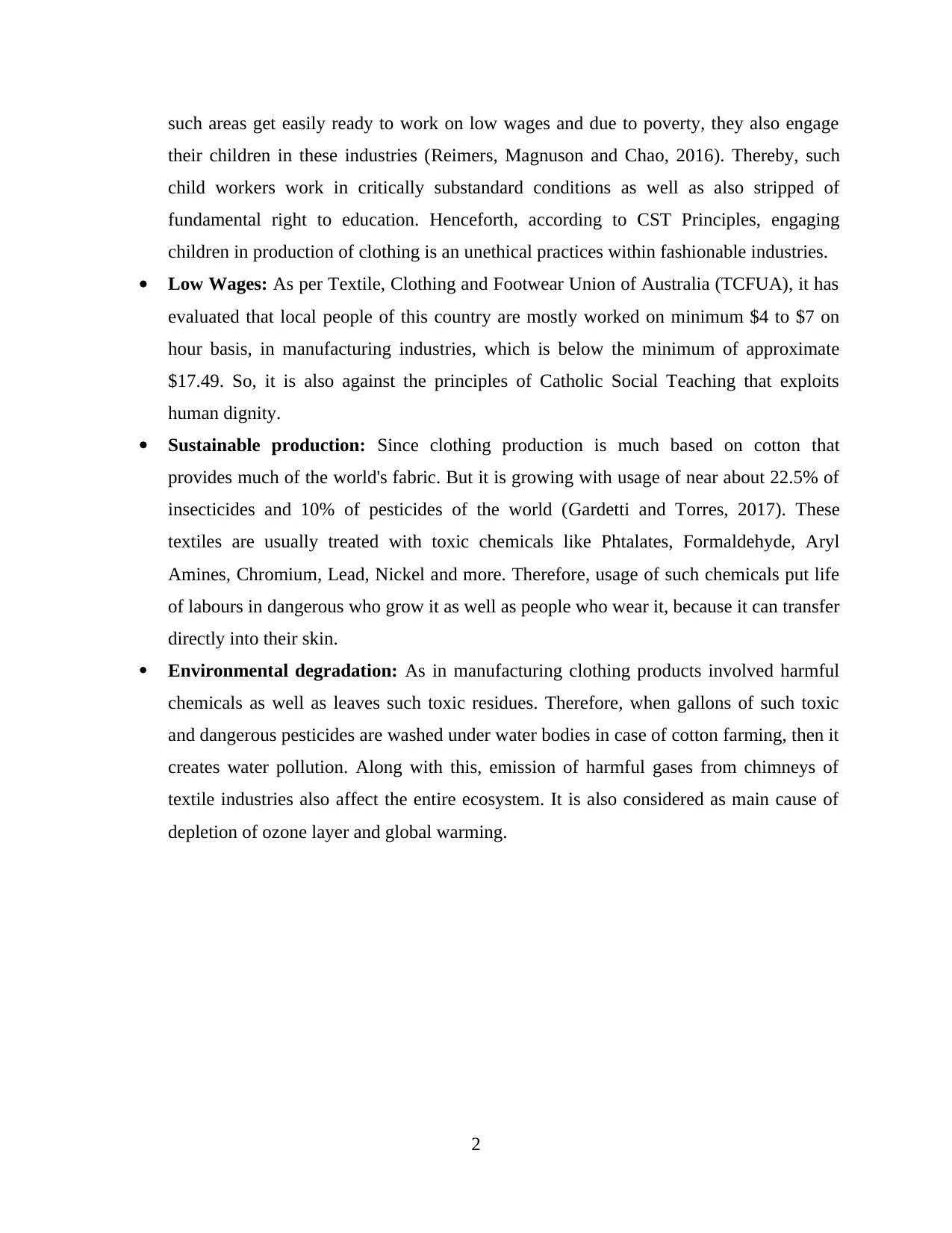
such areas get easily ready to work on low wages and due to poverty, they also engage
their children in these industries (Reimers, Magnuson and Chao, 2016). Thereby, such
child workers work in critically substandard conditions as well as also stripped of
fundamental right to education. Henceforth, according to CST Principles, engaging
children in production of clothing is an unethical practices within fashionable industries.
Low Wages: As per Textile, Clothing and Footwear Union of Australia (TCFUA), it has
evaluated that local people of this country are mostly worked on minimum $4 to $7 on
hour basis, in manufacturing industries, which is below the minimum of approximate
$17.49. So, it is also against the principles of Catholic Social Teaching that exploits
human dignity.
Sustainable production: Since clothing production is much based on cotton that
provides much of the world's fabric. But it is growing with usage of near about 22.5% of
insecticides and 10% of pesticides of the world (Gardetti and Torres, 2017). These
textiles are usually treated with toxic chemicals like Phtalates, Formaldehyde, Aryl
Amines, Chromium, Lead, Nickel and more. Therefore, usage of such chemicals put life
of labours in dangerous who grow it as well as people who wear it, because it can transfer
directly into their skin.
Environmental degradation: As in manufacturing clothing products involved harmful
chemicals as well as leaves such toxic residues. Therefore, when gallons of such toxic
and dangerous pesticides are washed under water bodies in case of cotton farming, then it
creates water pollution. Along with this, emission of harmful gases from chimneys of
textile industries also affect the entire ecosystem. It is also considered as main cause of
depletion of ozone layer and global warming.
2
their children in these industries (Reimers, Magnuson and Chao, 2016). Thereby, such
child workers work in critically substandard conditions as well as also stripped of
fundamental right to education. Henceforth, according to CST Principles, engaging
children in production of clothing is an unethical practices within fashionable industries.
Low Wages: As per Textile, Clothing and Footwear Union of Australia (TCFUA), it has
evaluated that local people of this country are mostly worked on minimum $4 to $7 on
hour basis, in manufacturing industries, which is below the minimum of approximate
$17.49. So, it is also against the principles of Catholic Social Teaching that exploits
human dignity.
Sustainable production: Since clothing production is much based on cotton that
provides much of the world's fabric. But it is growing with usage of near about 22.5% of
insecticides and 10% of pesticides of the world (Gardetti and Torres, 2017). These
textiles are usually treated with toxic chemicals like Phtalates, Formaldehyde, Aryl
Amines, Chromium, Lead, Nickel and more. Therefore, usage of such chemicals put life
of labours in dangerous who grow it as well as people who wear it, because it can transfer
directly into their skin.
Environmental degradation: As in manufacturing clothing products involved harmful
chemicals as well as leaves such toxic residues. Therefore, when gallons of such toxic
and dangerous pesticides are washed under water bodies in case of cotton farming, then it
creates water pollution. Along with this, emission of harmful gases from chimneys of
textile industries also affect the entire ecosystem. It is also considered as main cause of
depletion of ozone layer and global warming.
2
Paraphrase This Document
Need a fresh take? Get an instant paraphrase of this document with our AI Paraphraser
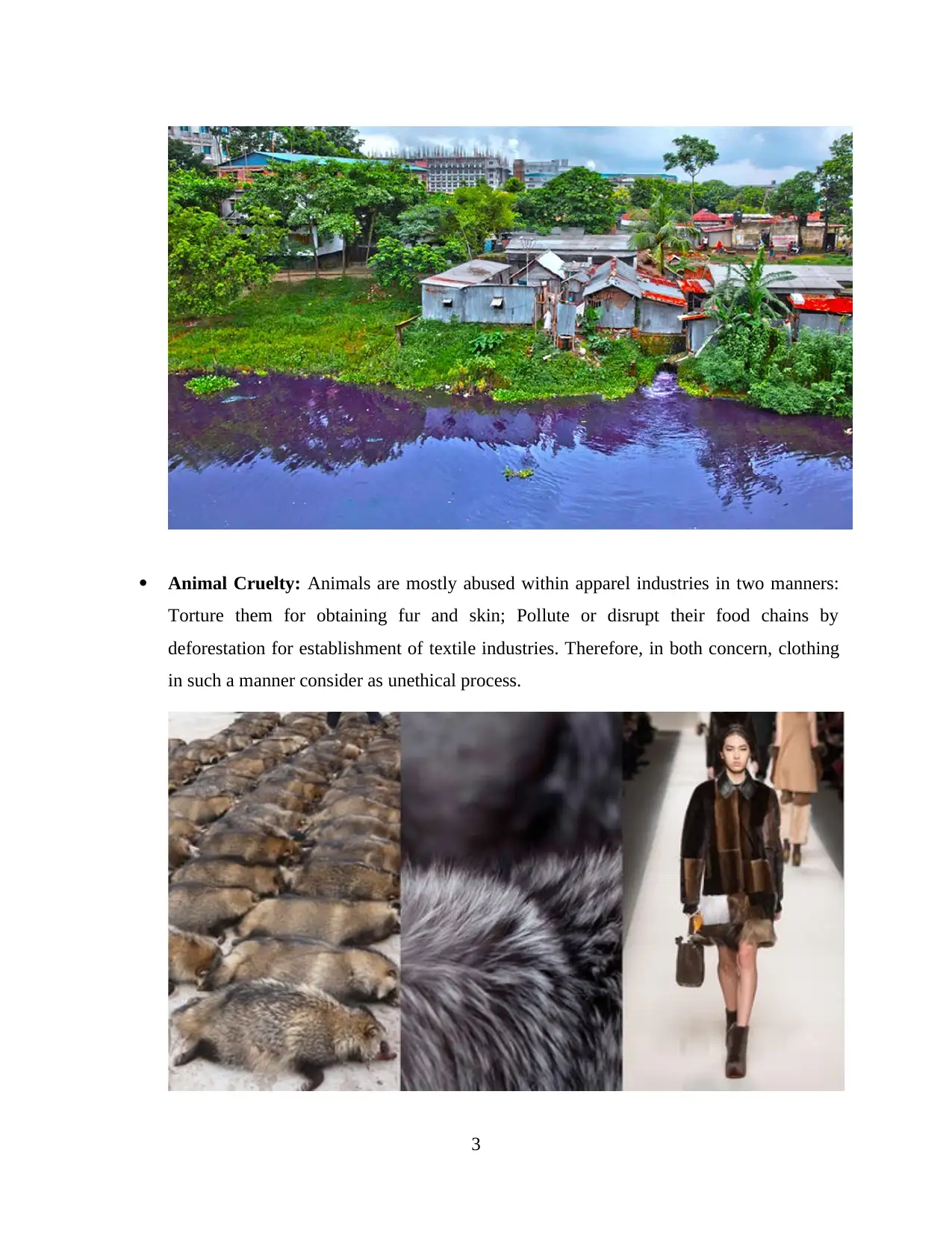
Animal Cruelty: Animals are mostly abused within apparel industries in two manners:
Torture them for obtaining fur and skin; Pollute or disrupt their food chains by
deforestation for establishment of textile industries. Therefore, in both concern, clothing
in such a manner consider as unethical process.
3
Torture them for obtaining fur and skin; Pollute or disrupt their food chains by
deforestation for establishment of textile industries. Therefore, in both concern, clothing
in such a manner consider as unethical process.
3
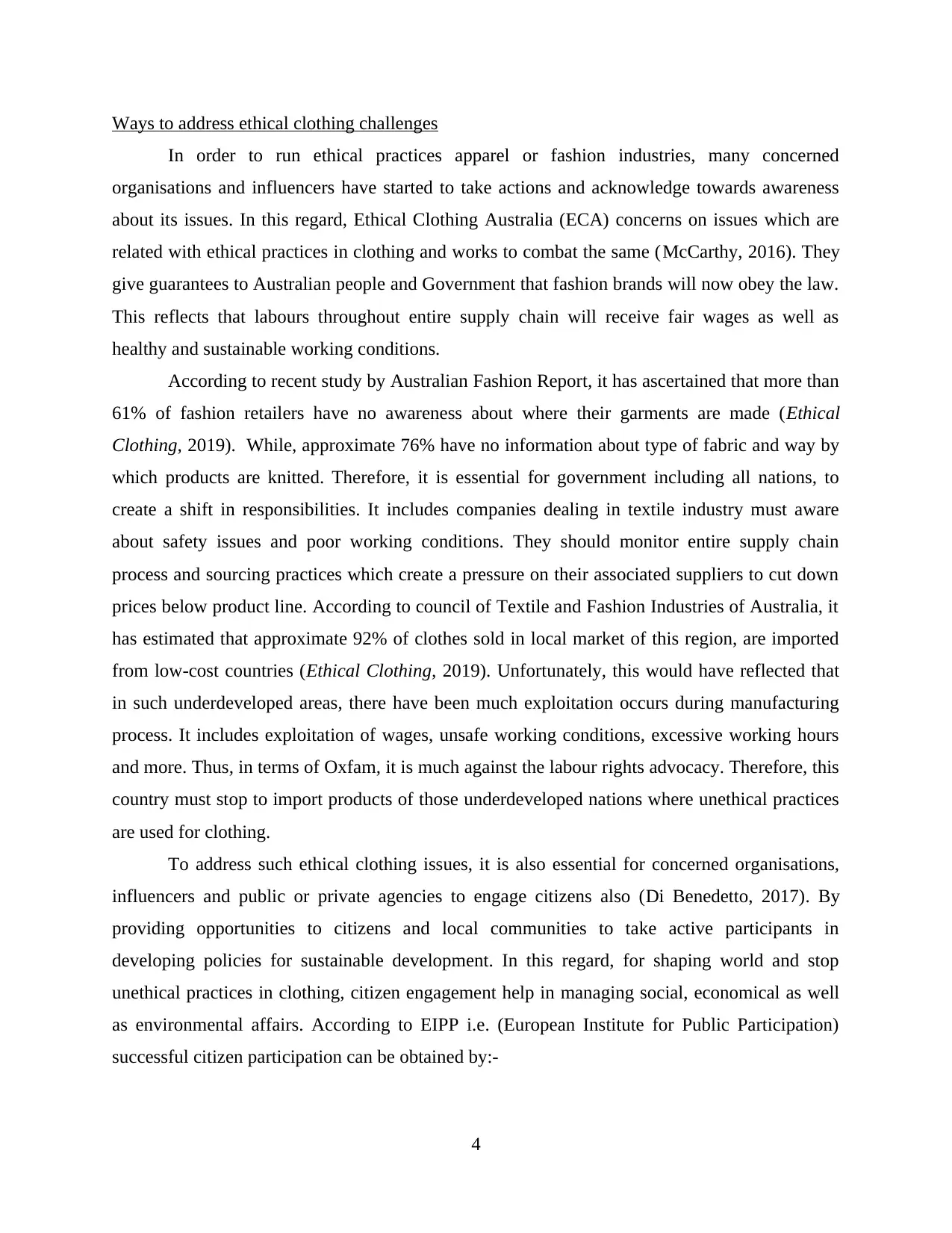
Ways to address ethical clothing challenges
In order to run ethical practices apparel or fashion industries, many concerned
organisations and influencers have started to take actions and acknowledge towards awareness
about its issues. In this regard, Ethical Clothing Australia (ECA) concerns on issues which are
related with ethical practices in clothing and works to combat the same (McCarthy, 2016). They
give guarantees to Australian people and Government that fashion brands will now obey the law.
This reflects that labours throughout entire supply chain will receive fair wages as well as
healthy and sustainable working conditions.
According to recent study by Australian Fashion Report, it has ascertained that more than
61% of fashion retailers have no awareness about where their garments are made (Ethical
Clothing, 2019). While, approximate 76% have no information about type of fabric and way by
which products are knitted. Therefore, it is essential for government including all nations, to
create a shift in responsibilities. It includes companies dealing in textile industry must aware
about safety issues and poor working conditions. They should monitor entire supply chain
process and sourcing practices which create a pressure on their associated suppliers to cut down
prices below product line. According to council of Textile and Fashion Industries of Australia, it
has estimated that approximate 92% of clothes sold in local market of this region, are imported
from low-cost countries (Ethical Clothing, 2019). Unfortunately, this would have reflected that
in such underdeveloped areas, there have been much exploitation occurs during manufacturing
process. It includes exploitation of wages, unsafe working conditions, excessive working hours
and more. Thus, in terms of Oxfam, it is much against the labour rights advocacy. Therefore, this
country must stop to import products of those underdeveloped nations where unethical practices
are used for clothing.
To address such ethical clothing issues, it is also essential for concerned organisations,
influencers and public or private agencies to engage citizens also (Di Benedetto, 2017). By
providing opportunities to citizens and local communities to take active participants in
developing policies for sustainable development. In this regard, for shaping world and stop
unethical practices in clothing, citizen engagement help in managing social, economical as well
as environmental affairs. According to EIPP i.e. (European Institute for Public Participation)
successful citizen participation can be obtained by:-
4
In order to run ethical practices apparel or fashion industries, many concerned
organisations and influencers have started to take actions and acknowledge towards awareness
about its issues. In this regard, Ethical Clothing Australia (ECA) concerns on issues which are
related with ethical practices in clothing and works to combat the same (McCarthy, 2016). They
give guarantees to Australian people and Government that fashion brands will now obey the law.
This reflects that labours throughout entire supply chain will receive fair wages as well as
healthy and sustainable working conditions.
According to recent study by Australian Fashion Report, it has ascertained that more than
61% of fashion retailers have no awareness about where their garments are made (Ethical
Clothing, 2019). While, approximate 76% have no information about type of fabric and way by
which products are knitted. Therefore, it is essential for government including all nations, to
create a shift in responsibilities. It includes companies dealing in textile industry must aware
about safety issues and poor working conditions. They should monitor entire supply chain
process and sourcing practices which create a pressure on their associated suppliers to cut down
prices below product line. According to council of Textile and Fashion Industries of Australia, it
has estimated that approximate 92% of clothes sold in local market of this region, are imported
from low-cost countries (Ethical Clothing, 2019). Unfortunately, this would have reflected that
in such underdeveloped areas, there have been much exploitation occurs during manufacturing
process. It includes exploitation of wages, unsafe working conditions, excessive working hours
and more. Thus, in terms of Oxfam, it is much against the labour rights advocacy. Therefore, this
country must stop to import products of those underdeveloped nations where unethical practices
are used for clothing.
To address such ethical clothing issues, it is also essential for concerned organisations,
influencers and public or private agencies to engage citizens also (Di Benedetto, 2017). By
providing opportunities to citizens and local communities to take active participants in
developing policies for sustainable development. In this regard, for shaping world and stop
unethical practices in clothing, citizen engagement help in managing social, economical as well
as environmental affairs. According to EIPP i.e. (European Institute for Public Participation)
successful citizen participation can be obtained by:-
4
⊘ This is a preview!⊘
Do you want full access?
Subscribe today to unlock all pages.

Trusted by 1+ million students worldwide
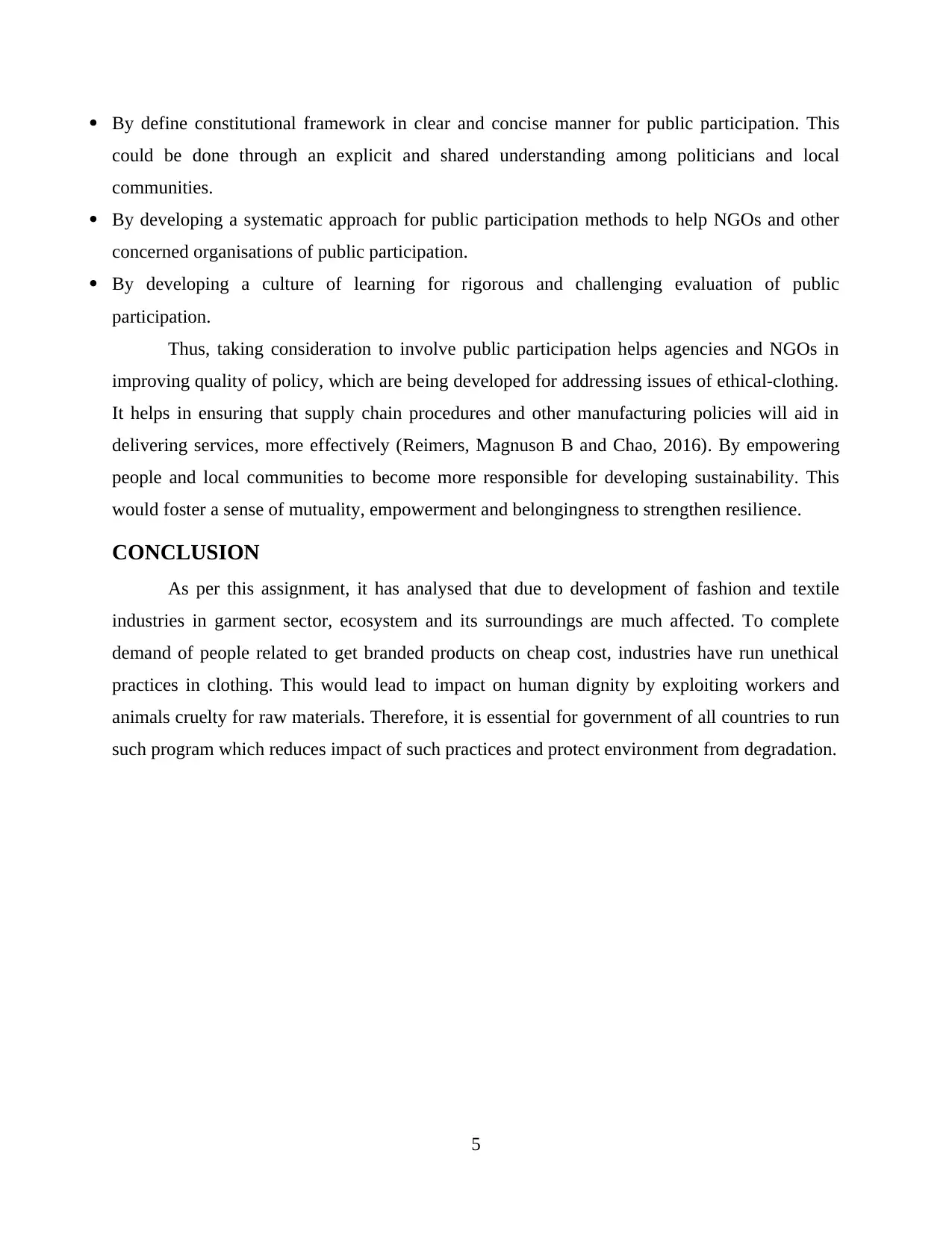
By define constitutional framework in clear and concise manner for public participation. This
could be done through an explicit and shared understanding among politicians and local
communities.
By developing a systematic approach for public participation methods to help NGOs and other
concerned organisations of public participation.
By developing a culture of learning for rigorous and challenging evaluation of public
participation.
Thus, taking consideration to involve public participation helps agencies and NGOs in
improving quality of policy, which are being developed for addressing issues of ethical-clothing.
It helps in ensuring that supply chain procedures and other manufacturing policies will aid in
delivering services, more effectively (Reimers, Magnuson B and Chao, 2016). By empowering
people and local communities to become more responsible for developing sustainability. This
would foster a sense of mutuality, empowerment and belongingness to strengthen resilience.
CONCLUSION
As per this assignment, it has analysed that due to development of fashion and textile
industries in garment sector, ecosystem and its surroundings are much affected. To complete
demand of people related to get branded products on cheap cost, industries have run unethical
practices in clothing. This would lead to impact on human dignity by exploiting workers and
animals cruelty for raw materials. Therefore, it is essential for government of all countries to run
such program which reduces impact of such practices and protect environment from degradation.
5
could be done through an explicit and shared understanding among politicians and local
communities.
By developing a systematic approach for public participation methods to help NGOs and other
concerned organisations of public participation.
By developing a culture of learning for rigorous and challenging evaluation of public
participation.
Thus, taking consideration to involve public participation helps agencies and NGOs in
improving quality of policy, which are being developed for addressing issues of ethical-clothing.
It helps in ensuring that supply chain procedures and other manufacturing policies will aid in
delivering services, more effectively (Reimers, Magnuson B and Chao, 2016). By empowering
people and local communities to become more responsible for developing sustainability. This
would foster a sense of mutuality, empowerment and belongingness to strengthen resilience.
CONCLUSION
As per this assignment, it has analysed that due to development of fashion and textile
industries in garment sector, ecosystem and its surroundings are much affected. To complete
demand of people related to get branded products on cheap cost, industries have run unethical
practices in clothing. This would lead to impact on human dignity by exploiting workers and
animals cruelty for raw materials. Therefore, it is essential for government of all countries to run
such program which reduces impact of such practices and protect environment from degradation.
5
Paraphrase This Document
Need a fresh take? Get an instant paraphrase of this document with our AI Paraphraser
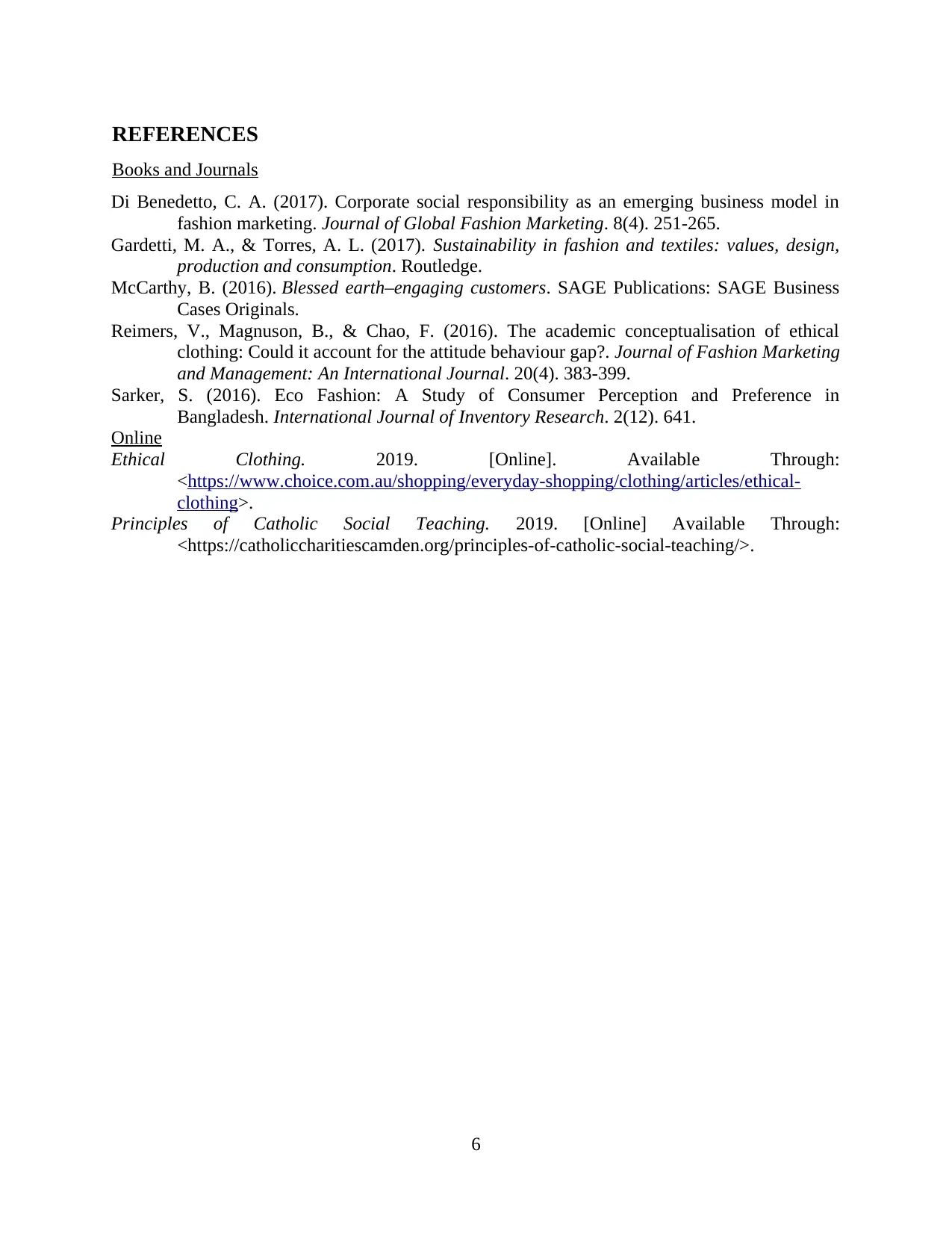
REFERENCES
Books and Journals
Di Benedetto, C. A. (2017). Corporate social responsibility as an emerging business model in
fashion marketing. Journal of Global Fashion Marketing. 8(4). 251-265.
Gardetti, M. A., & Torres, A. L. (2017). Sustainability in fashion and textiles: values, design,
production and consumption. Routledge.
McCarthy, B. (2016). Blessed earth–engaging customers. SAGE Publications: SAGE Business
Cases Originals.
Reimers, V., Magnuson, B., & Chao, F. (2016). The academic conceptualisation of ethical
clothing: Could it account for the attitude behaviour gap?. Journal of Fashion Marketing
and Management: An International Journal. 20(4). 383-399.
Sarker, S. (2016). Eco Fashion: A Study of Consumer Perception and Preference in
Bangladesh. International Journal of Inventory Research. 2(12). 641.
Online
Ethical Clothing. 2019. [Online]. Available Through:
<https://www.choice.com.au/shopping/everyday-shopping/clothing/articles/ethical-
clothing>.
Principles of Catholic Social Teaching. 2019. [Online] Available Through:
<https://catholiccharitiescamden.org/principles-of-catholic-social-teaching/>.
6
Books and Journals
Di Benedetto, C. A. (2017). Corporate social responsibility as an emerging business model in
fashion marketing. Journal of Global Fashion Marketing. 8(4). 251-265.
Gardetti, M. A., & Torres, A. L. (2017). Sustainability in fashion and textiles: values, design,
production and consumption. Routledge.
McCarthy, B. (2016). Blessed earth–engaging customers. SAGE Publications: SAGE Business
Cases Originals.
Reimers, V., Magnuson, B., & Chao, F. (2016). The academic conceptualisation of ethical
clothing: Could it account for the attitude behaviour gap?. Journal of Fashion Marketing
and Management: An International Journal. 20(4). 383-399.
Sarker, S. (2016). Eco Fashion: A Study of Consumer Perception and Preference in
Bangladesh. International Journal of Inventory Research. 2(12). 641.
Online
Ethical Clothing. 2019. [Online]. Available Through:
<https://www.choice.com.au/shopping/everyday-shopping/clothing/articles/ethical-
clothing>.
Principles of Catholic Social Teaching. 2019. [Online] Available Through:
<https://catholiccharitiescamden.org/principles-of-catholic-social-teaching/>.
6
1 out of 8
Related Documents
Your All-in-One AI-Powered Toolkit for Academic Success.
+13062052269
info@desklib.com
Available 24*7 on WhatsApp / Email
![[object Object]](/_next/static/media/star-bottom.7253800d.svg)
Unlock your academic potential
Copyright © 2020–2025 A2Z Services. All Rights Reserved. Developed and managed by ZUCOL.





